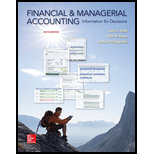
Concept explainers
Asset:
It refers to all valuable items that a company owns or items that generate some income to the company whether tangible or intangible. The more assets a company owns, the stable its financial position would be.
Accounting rule for assets is,
- Increase in assets is always debited
- Decrease in assets is always credited.
Liability: It refers to all items that have some monetary value in market and that company owes from others. The liability is much important for a company for financial support.
Accounting rule for liabilities is,
- Increase in liabilities is always credited.
- Decrease in assets is always credited.
Equity: It refers to the contribution that an owner makes to the company. The more equity the company has, the more profitable the company would be.
Accounting rule for equity is,
- Increase in Equity is always credited.
- Decrease in equity is always debited.
To classify: Items into asset (A) account, liability (L) account and equity (EQ) account.
Want to see the full answer?
Check out a sample textbook solution
Chapter 2 Solutions
Financial and Managerial Accounting: Information for Decisions
- Yamamoto Corporation began the accounting period with $92,000 of merchandise, and the net cost of purchases was $318,000. A physical inventory showed $104,000 of merchandise unsold at the end of the period. The cost of goods sold by Yamamoto Corporation for the period is __. need helparrow_forwardI need help with this general accounting problem using proper accounting guidelines.arrow_forwardAn asset owned by Crescent Manufacturing has a book value of $36,000 on June 30, Year 5. The asset has been depreciated at an annual rate of $8,000 using the straight-line method. Assuming the asset is sold on June 30, Year 5 for $39,500, how should the company record the transaction? a. Neither a gain nor a loss is recognized on this type of transaction. b. A gain on sale of $3,500. c. A gain on sale of $5,000. d. A loss on sale of $3,500. e. A loss on sale of $5,000.arrow_forward
- I am looking for help with this general accounting question using proper accounting standards.arrow_forwardCan you explain the correct approach to solve this financial accounting question?arrow_forwardJacobson Co. recently reported a net income of $7,840 and depreciation of $1,250. How much was its net cash flow, assuming it had no amortization expense and sold none of its fixed assets? HELParrow_forward
- Yamamoto Corporation began the accounting period with $92,000 of merchandise, and the net cost of purchases was $318,000. A physical inventory showed $104,000 of merchandise unsold at the end of the period. The cost of goods sold by Yamamoto Corporation for the period is __.arrow_forwardI am trying to find the accurate solution to this general accounting problem with appropriate explanations.arrow_forwardGeneral accountingarrow_forward

 AccountingAccountingISBN:9781337272094Author:WARREN, Carl S., Reeve, James M., Duchac, Jonathan E.Publisher:Cengage Learning,
AccountingAccountingISBN:9781337272094Author:WARREN, Carl S., Reeve, James M., Duchac, Jonathan E.Publisher:Cengage Learning, Accounting Information SystemsAccountingISBN:9781337619202Author:Hall, James A.Publisher:Cengage Learning,
Accounting Information SystemsAccountingISBN:9781337619202Author:Hall, James A.Publisher:Cengage Learning, Horngren's Cost Accounting: A Managerial Emphasis...AccountingISBN:9780134475585Author:Srikant M. Datar, Madhav V. RajanPublisher:PEARSON
Horngren's Cost Accounting: A Managerial Emphasis...AccountingISBN:9780134475585Author:Srikant M. Datar, Madhav V. RajanPublisher:PEARSON Intermediate AccountingAccountingISBN:9781259722660Author:J. David Spiceland, Mark W. Nelson, Wayne M ThomasPublisher:McGraw-Hill Education
Intermediate AccountingAccountingISBN:9781259722660Author:J. David Spiceland, Mark W. Nelson, Wayne M ThomasPublisher:McGraw-Hill Education Financial and Managerial AccountingAccountingISBN:9781259726705Author:John J Wild, Ken W. Shaw, Barbara Chiappetta Fundamental Accounting PrinciplesPublisher:McGraw-Hill Education
Financial and Managerial AccountingAccountingISBN:9781259726705Author:John J Wild, Ken W. Shaw, Barbara Chiappetta Fundamental Accounting PrinciplesPublisher:McGraw-Hill Education





